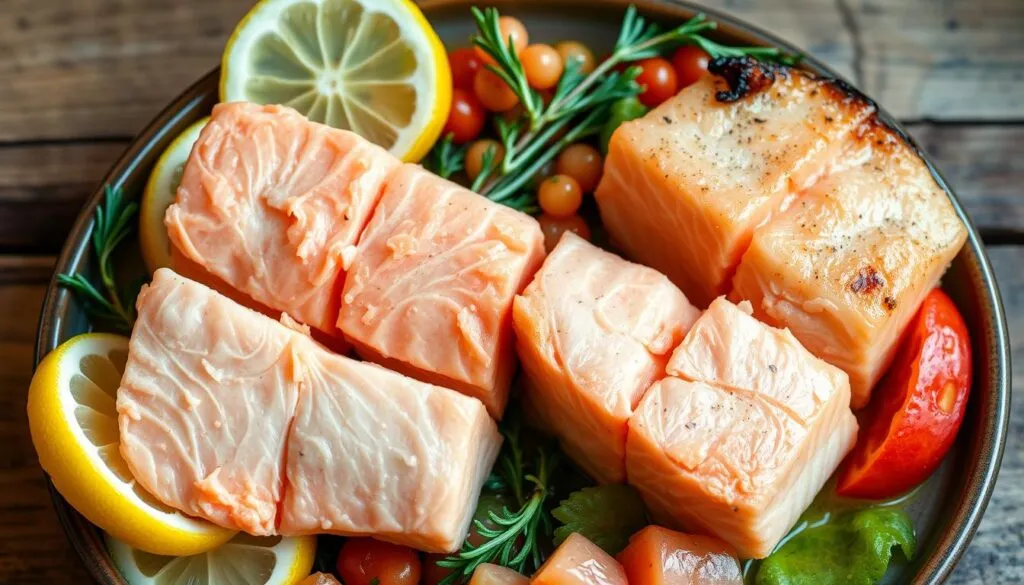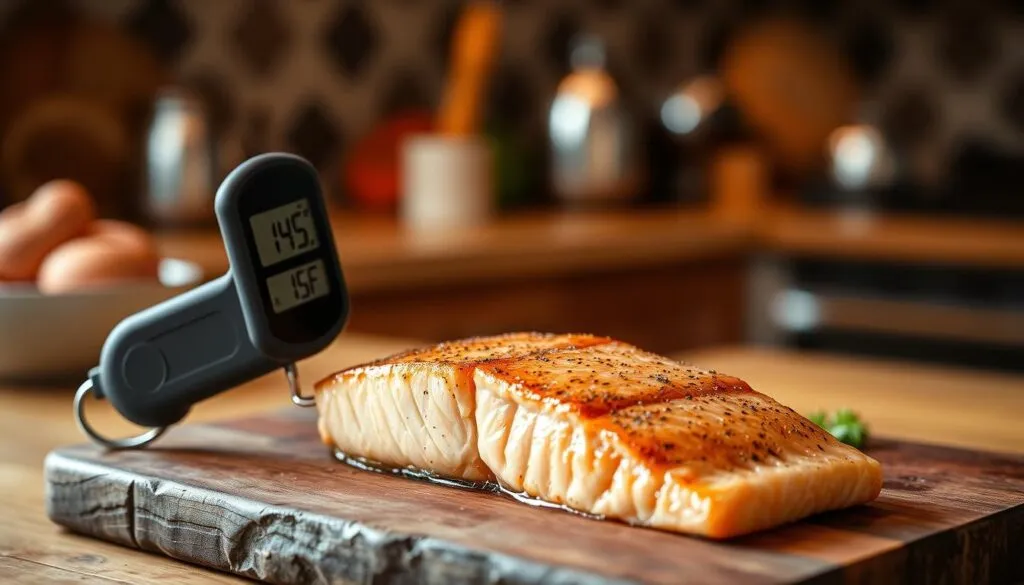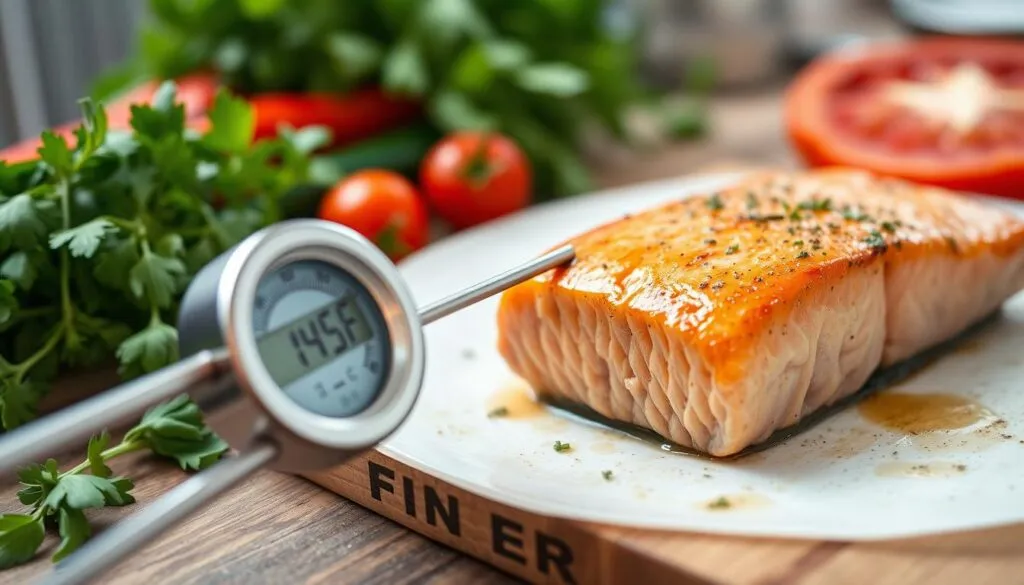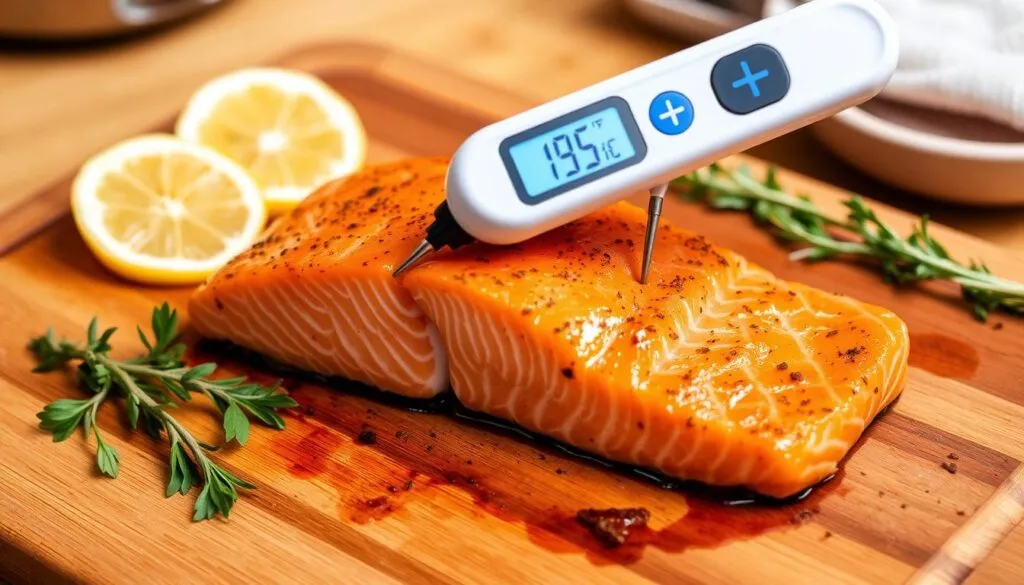When cooking salmon, you want it to be perfect. The question, is salmon done at 145℉ or 165℉? The USDA says 145°F is safe. But, some say 120°F or 125°F makes it tender and tasty.
Exploring salmon cooking, you’ll find a debate on the best internal temperature. You’ll see why the right temperature matters for texture and taste. This article will help you find the perfect doneness for your salmon, whether it’s 145 ℉ or 165 ℉.
Table of Contents
Understanding Salmon Cooking Temperatures Basics
Cooking salmon right is key. The ideal temperature is 145°F. This keeps it moist and safe to eat. Some like it hotter, up to 165°F, for extra safety.
To see if salmon is done, look for a flaky texture. It should be 145°F. Cooking it too long can make it dry. The USDA says 145°F is safe and healthy.
Here are some key points to consider when cooking salmon:
- Cooking temperature: 145°F for a moist texture and food safety
- Salmon doneness temperature: 145°F for a flaky texture
- Higher cooking temperature: 165°F, but may result in a dry texture
- Food safety: cooking salmon to 145°F ensures a 99.9% reduction of foodborne pathogens
Knowing about salmon cooking temperatures helps you cook it safely and well. Whether you choose 145°F or 165°F, always use a meat thermometer. This ensures your salmon is cooked right.
| Cooking Temperature | Texture | Food Safety |
|---|---|---|
| 145°F | Moist and flaky | 99.9% reduction of foodborne pathogens |
| 165°F | Dry and overcooked | Higher risk of foodborne illness |
Is salmon done at 145℉ or 165℉ ?
Cooking salmon right is key for safety and taste. The USDA says to cook it to at least 145°F to kill harmful bacteria. But, some chefs think cooking it to 125°F or 130°F makes it more tender and tasty.
Choosing the right cooking salmon temperature depends on the salmon type and your taste. Wild-caught salmon might cook faster than farmed salmon. Always use a food thermometer to check the salmon internal temperature, even if you’re cooking it lower.
Here are some key considerations when deciding on a cooking temperature:
- Food safety: Cooking to an internal temperature of at least 145°F ensures that harmful bacteria are killed.
- Texture and flavor: Cooking to a lower temperature can result in a more tender and flavorful dish.
- Personal preference: Some people prefer their salmon cooked to a higher temperature for a firmer texture.
The choice of cooking salmon temperature is up to you. Knowing how the safe salmon cooking temperature and salmon internal temperature affect your dish helps. This way, you can enjoy a tasty and safe salmon meal.
Food Safety Guidelines for Cooking Salmon
Cooking salmon safely is very important. You need to make sure it’s cooked to a safe temperature to avoid getting sick. The FDA and USDA say the safe temperature is at least 145°F. It’s key to use a thermometer to check this.
To keep your salmon safe, follow some important guidelines. Handle and store it right, cook it to the right temperature, and refrigerate or freeze it quickly after. These steps help you enjoy your salmon safely.
Understanding the Temperature Danger Zone
The danger zone for bacteria is between 41°F and 135°F. To stay out of this zone, cook your salmon to the safe temperature and refrigerate or freeze it fast. A thermometer helps make sure it’s cooked right.
Additional Safety Tips
There are more ways to keep your salmon safe. These include:
- Handling salmon safely to avoid contamination
- Cooking it to the right temperature to kill harmful bacteria
- Refrigerating or freezing it quickly to stop bacteria from growing
By following these tips and using a thermometer, you can enjoy your salmon safely.
Texture and Flavor Differences Between 145°F and 165°F
Cooking salmon to the right temperature is key for its texture and taste. To know if salmon is done, you need to check the salmon doneness temperature. Cooking it to 145°F makes it tender and moist. But, cooking it to 165°F can make it dry and overcooked.
The cooking salmon temperature also changes its flavor. Lower temperatures keep the salmon’s natural taste. But, higher temperatures can make it lose its flavor. It’s important to watch the temperature and adjust cooking time to get the best taste and texture.

- Internal temperature: Ensure the salmon reaches a safe internal temperature to avoid foodborne illness.
- Cooking time: Adjust the cooking time based on the thickness of the salmon and the desired level of doneness.
- Temperature control: Use a thermometer to monitor the temperature and prevent overcooking.
Knowing how temperature affects salmon can help you make a delicious dish. Always use a thermometer to ensure the salmon doneness temperature is met. This way, you can impress your guests with moist and tasty salmon.
Choosing the Right Cooking Temperature Based on Preparation Method
When cooking salmon, the right temperature is key for safety and taste. A thermometer for cooking salmon is vital for the proper salmon cooking temperature. The cooking salmon temperature changes with the cooking method.
Baking needs a lower heat than grilling or pan-searing. Adjust the time and temperature based on the salmon’s thickness and your desired doneness.
- Baking: 400°F (200°C) for 12-15 minutes per inch of thickness
- Grilling: 400°F (200°C) for 4-6 minutes per side
- Pan-searing: 400°F (200°C) for 3-5 minutes per side
Perfect salmon doneness comes from cooking it to the right temperature. A thermometer for cooking salmon ensures the proper salmon cooking temperature. This makes your meal delicious and safe.
Using a Meat Thermometer for Perfect Salmon
To cook your salmon right, you need a thermometer. It ensures your salmon is cooked safely. The key temperature is 145°F (63°C), or when the flesh is no longer pink.
When picking a thermometer, look at digital and analog options. Make sure to place the probe right to get accurate readings. It should go at least ½ inch into the thickest part of the meat.
Key Considerations for Thermometer Use
- Choose a thermometer that is easy to use and provides accurate readings.
- Insert the probe correctly to avoid false readings.
- Wait for the temperature to stabilize before taking a reading.
By following these tips and using a thermometer, you can cook your salmon safely. This prevents foodborne illness and makes you feel confident when serving. Remember, a thermometer is key for the right cooking temperature, so use it.

Special Considerations for Different Salmon Cuts
Cooking salmon right is key for safety and taste. The salmon internal temperature varies with the cut’s type and thickness. Thicker cuts need more time to reach the salmon doneness temperature.
To check if salmon is cooked, a meat thermometer is best. It should read at least 145°F. But, the time and temperature can change based on the cut. For example, fillets and steaks cook differently than whole salmon.
- Salmon fillets: These are thinner and cook faster, needing a lower temperature.
- Salmon steaks: Thicker and more robust, they need longer cooking and higher heat.
- Whole salmon: This takes the longest to cook, needing the highest temperature to cook through to the bone.
Knowing the cut’s type and thickness helps cook salmon perfectly. This ensures it’s both delicious and safe to eat.
Common Mistakes When Checking Salmon Temperature
When cooking salmon, it’s key to check the temperature. This ensures it’s cooked safely. A thermometer is a must-have tool for this task. Yet, many people make mistakes that can ruin the salmon.
To avoid these errors, knowing the right cooking temperature is important. Also, learning how to use a thermometer correctly is essential. A common mistake is not calibrating the thermometer right, leading to wrong readings. Another error is not placing the thermometer in the thickest part of the salmon, causing uneven cooking.
Temperature Reading Errors
Reading temperature wrong can happen if the thermometer is not used right. It’s important to put the thermometer in the thickest part of the salmon. Wait a few seconds for an accurate reading. A safe cooking temperature is key to avoid food poisoning.
Timing Mistakes
Timing is also a factor when cooking salmon. It’s important to check the temperature at the right moment. Using a thermometer helps avoid these timing mistakes, ensuring your salmon is cooked just right.

Equipment Problems
Equipment issues can also cause problems when checking salmon temperature. It’s vital to use a trustworthy thermometer and make sure it’s calibrated. By avoiding these mistakes, you can ensure your salmon is cooked safely and tastes great.
Professional Chef Tips for Perfect Salmon Doneness
Cooking salmon to perfection can be tricky. You want it to be safe to eat and full of flavor. Professional chefs say to cook salmon to a safe salmon cooking temperature of 145°F for the best results.
Choosing the right cooking method is key. Grilling and pan-searing are great because they make the outside crispy and the inside juicy. It’s also important to check the salmon internal temperature with a meat thermometer. This ensures it’s cooked safely.
Here are some tips from professional chefs for perfect salmon:
- Cook salmon to an internal temperature of 145°F for optimal moisture and flavor
- Use a meat thermometer to check the cooking salmon temperature and ensure it reaches a safe minimum internal temperature
- Don’t overcook salmon, as it can become dry and tough
- Let salmon rest for a few minutes before serving to allow the juices to redistribute
Follow these tips and use the right cooking methods for perfect salmon. Always prioritize food safety and cook your salmon to a safe salmon cooking temperature to avoid foodborne illness.
Conclusion: Making the Right Temperature Choice for Your Salmon
When cooking salmon, the right internal temperature is key. The choice between 145°F and 165°F greatly affects the dish’s texture and taste. Cooking to 145°F keeps salmon moist and tender, while 165°F can make it dry and stiff.
Your preference, the salmon type, and cooking method guide your choice. For a moist, medium-rare salmon, aim for 145°F. If you like it well-done and flaky, go for 165°F. But, always cook salmon to at least 145°F for food safety.
Knowing about salmon doneness and temperature changes helps you choose wisely. This ensures a delicious, perfectly cooked salmon every time.
FAQ
What is the USDA recommended internal temperature for cooked salmon?
The USDA says to cook salmon to 145°F (62.8°C) for safety.
Why is it important to use a meat thermometer when cooking salmon?
A meat thermometer is key for safe salmon cooking. It ensures you hit the right temperature and avoid overcooking. It helps you check if the salmon is done right.
What are the differences in texture and flavor between salmon cooked to 145°F and 165°F?
Salmon at 145°F is tender and moist, with a deep flavor. At 165°F, it’s firmer and drier, with a milder taste.
How should I adjust the cooking temperature and time based on the preparation method?
Cooking temperature and time vary by method. Baking salmon needs different settings than grilling or pan-searing. Adjust your cooking based on the method you choose.
What are some common mistakes to avoid when checking the temperature of cooked salmon?
Avoid mistakes like wrong thermometer use, not waiting for stable temperature, and ignoring salmon thickness. Proper use and understanding temperature changes are vital for perfect doneness.
Follow us on Facebook: https://www.facebook.com/AnyTimesRecipes/
For more easy and flavorful recipes, check out: How to Smoke Salmon – A Complete Recipe Guide

